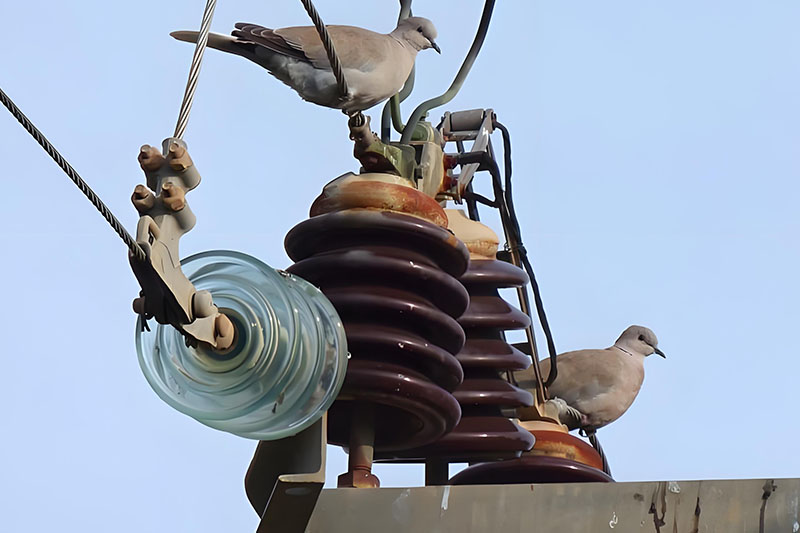
In the operation of power grids and substations, bird activity has become a significant threat to the safety and stability of the power system. According to maintenance data from State Grid Corporation of China, bird-related equipment failures account for 15% to 20% of all incidents, with frequent occurrences during bird migration and breeding seasons. As smart grid development progresses, the need for efficient and environmentally friendly bird hazard solutions has become a central focus in the power industry. The emergence of new laser bird repellent technology offers an innovative answer to this challenge.
Bird Hazards in Power Grids and Substations: From Equipment Damage to Large-scale Outages
Bird activity near power infrastructure can cause multiple types of risks, mainly including:
Insulator Flashover Failures: Birds (such as magpies and crows) often nest or defecate on insulator strings. Their droppings and nesting materials (twigs, weeds) can bridge insulation gaps, reducing performance. In humid or foggy conditions, this can lead to flashovers, triggering line trips and even large-scale blackouts.
Conductor Short Circuits and Ground Faults: Birds carrying long branches or wires between conductors may cause phase-to-phase shorts. When resting on crossarms or tower tops, their bodies or droppings can directly connect conductors to grounding structures, causing single-phase ground faults.
Mechanical Damage to Equipment: Large birds (like eagles or hawks) may strike moving parts of switches or transformers when taking off or landing, deforming mechanical structures or causing malfunctions. Nesting material accumulation in ventilation areas can hinder cooling and accelerate component aging.
Fire and Explosion Risks: Bird droppings contain high levels of uric acid, which may corrode metal surfaces on high-temperature equipment. In substations, flammable materials carried by birds (such as dry grass or plastic) can ignite fires or explosions if they contact live or hot components.
Interference with Secondary Systems: Birds perching on control boxes or communication equipment may touch terminal strips or signal lines, triggering relay misoperations or communication failures, affecting grid dispatching.
Limitations of Traditional Bird Repellent Methods
Various traditional approaches have been used in the power sector, but each comes with clear drawbacks:
Anti-perch Spikes: Initially effective but lose function over time as birds adapt or as vegetation covers the spikes.
Sound Repellents: Relies on high-frequency noise, but birds quickly become tolerant; can disturb substation personnel.
Reflective Mirrors/Windmills: Only effective in daylight; useless in rainy or nighttime conditions.
Manual Patrol and Cleaning: High labor costs and inability to provide real-time protection against bird intrusion.
New Laser Bird Repellent Technology: A Precise, Intelligent, and Sustainable Solution
To address the shortcomings of traditional methods, 86Laser’s intelligent laser bird repellent system offers a new option for grid and substation bird control. It operates by emitting low-power, eye-safe visible laser beams (typically green), creating dynamic light spots around equipment. Birds instinctively avoid these stimuli.
Key technical advantages that make laser repellents suitable for grid scenarios include:
Targeted Coverage: Lasers can be directed at high-risk areas such as insulator strings, crossarms, and control boxes, avoiding indiscriminate illumination and reducing light pollution.
Round-the-Clock Operation: Visible lasers work during the day, while infrared lasers (within safety standards) can operate at night, enabling 24-hour protection.
Smart Integration and Automation: Supports integration with radar and infrared sensors, activating only when birds enter protected zones to save energy. Some models offer timed scanning to match bird activity patterns.
Environmentally Safe: Laser power is strictly controlled within international safety limits, ensuring no harm to birds or power equipment.
Application cases demonstrate the shift from reactive repairs to proactive prevention:
At a 500kV substation in East China, laser units installed near insulator strings and crossarms reduced bird nesting by 90% and bird-induced trip events by 85%.
At a wind power hub in Northwest China, high-power laser systems integrated with radar deterred large birds like eagles throughout their entire flight process, resulting in a 70% reduction in equipment failures.
In a rain-prone southern region, IP65-rated laser devices with infrared sensors maintained over 90% repellent efficiency even in foggy and wet conditions.
As smart grid upgrades continue, laser bird repellent systems are evolving from standalone devices to integrated protection platforms. Bird activity presents complex challenges to grid and substation safety, and traditional repellent methods are no longer sufficient. With its precision, intelligence, and sustainability, laser bird deterrent technology is becoming the preferred solution in the power industry.
86Laser will continue to advance innovation in laser bird control, providing reliable and intelligent protection for power grids and substations worldwide, ensuring the safe and stable delivery of every unit of electricity.




